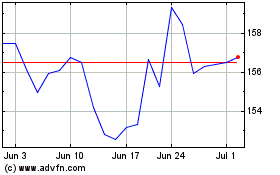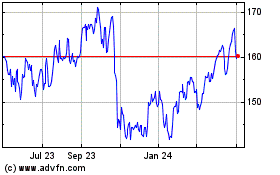Summer Offers Refiners No Relief -- WSJ
July 25 2016 - 3:03AM
Dow Jones News
By Alison Sider
Oil companies counted on American drivers hitting the road this
summer to reduce the glut of fuel in storage, but that hasn't
happened, and a continuing buildup portends dismal second-quarter
earnings due out soon.
Since crude prices plunged in 2014, giants like Exxon Mobil
Corp. and Chevron Corp. have leaned hard on their refining
operations to prop up declining profits from pumping oil. Those
margins helped stand-alone refiners like Valero Energy Corp. and
Marathon Petroleum Corp. emerge as bright spots in a dour energy
industry.
But turning crude into fuel has become less lucrative lately:
weaker refining margins slammed the independents' first-quarter
profits and hurt big oil companies' refining arms. The second
quarter appears just as bleak.
Summer is typically when people drive the most, boosting
refiners' profit. But during the recent quarter, refiners were hit
by rising crude oil prices. They also wound up paying more for
ethanol credits they need to buy to comply with a federal mandate,
which Tudor, Pickering, Holt & Co. analysts predicted will slim
second-quarter profits.
"Optimism for a good summer performance is rapidly evaporating,"
Roger Read, a refining analyst at Wells Fargo & Co., wrote
earlier this month.
It may get worse before it gets better. Projections for
refiners' third-quarter earnings may have to be revised down by 35%
to 40%, Deutsche Bank analysts said.
To be sure, refiners are still making money, and their margins
have improved since the first quarter. At today's benchmark prices,
the crack spread, or price difference between crude oil and
gasoline, stood recently at between $12 and $13 a barrel.
But while those margins are nothing to sneeze at, last year's
gasoline margins were nearly $17 higher, according to an Energy
Management Institute report.
Much of the trouble centers on gasoline. In conference calls in
April, refining executives were upbeat, anticipating that drivers
would hit the road in record numbers this year.
That largely came true. Although some gasoline demand figures
have come in weaker than expected, the U.S. Energy Information
Administration is still predicting that U.S. drivers will break the
2007 record for gasoline consumption. But it hasn't been enough to
fix the fuels glut.
"Demand has actually been quite strong. It's just that supply
has exceeded it," said Mark Broadbent, a research analyst at Wood
Mackenzie, a U.K.-based consultancy.
Refiners produced a big overhang of gasoline earlier this year
and still haven't been able to work through it. There are more than
241 million barrels of gasoline sitting in storage tanks, close to
25 million more than at this time last year. And while export
markets have historically provided a relief valve for surplus fuel,
this glut isn't confined to the U.S.
Many experts expect refiners will have to throttle back
production and stop buying so much crude if their margins keep
getting squeezed. Some East Coast refiners have already taken that
step.
Further cuts could weigh on oil prices. Already, West Texas
Intermediate, the U.S. benchmark, has started to slide, closing on
Friday at $44.19 a barrel, the lowest price since May.
"With such low operating margin and high gasoline inventories,
we could see economic run cuts, unusual for this time of the year,"
Wolfe Research analysts wrote earlier this month. "Nothing will
break our love of summer, but this one, it passed us by."
Write to Alison Sider at alison.sider@wsj.com
(END) Dow Jones Newswires
July 25, 2016 02:48 ET (06:48 GMT)
Copyright (c) 2016 Dow Jones & Company, Inc.
Chevron (NYSE:CVX)
Historical Stock Chart
From Mar 2024 to Apr 2024

Chevron (NYSE:CVX)
Historical Stock Chart
From Apr 2023 to Apr 2024
